#Famous Italian Trees
Explore tagged Tumblr posts
Text
Sicily's Mt. Etna is home to the largest and oldest sweet chestnut trees in the world. #100HorseChestnut #CastagnodellaNave #CastagnodeiCentoCavalli #GiantTrees
#chestnut blight#chestnut tree#Chestnuts as food#Famous Italian Trees#famous trees#food history#largest tree in circumference#largest trees#Mt Etna#oldest trees#trees in Sicily#world&039;s biggest trees
0 notes
Text
HONEYMOON
with Rafe Cameron
-> Rafe x F!Reader




📍 Amalfi Coast, Italy 🇮🇹
You knew honeymooning with Rafe Cameron would be an experience.
But as you step onto the sun drenched terrace of your private villa overlooking the endless stretch of the Mediterranean, waves crashing gently against the cliffs below, you realize nothing could have prepared you for this.
It’s breathtaking. The kind of view that belongs in a postcard, all golden light and soft ocean breeze, the scent of lemon trees lingering in the air.
And then there’s Rafe, grinning like he planned this entire thing himself (he didn’t), hands in his pockets, watching you expectantly.
“Well?” he prompts, shifting closer, voice dipping into something softer. “Worth marrying me for?”
You roll your eyes, but your smile betrays you. “Jury’s still out.”
Rafe hums, unconvinced. “Mm. Guess I’ll have to spend the next week proving you made the right choice.”
Before you can fire back, his arms loop around your waist, pulling you into him with that effortless ease, the kind that still makes your breath catch, even after everything. His lips find your temple, lingering just long enough to send warmth spreading through your chest.
And suddenly, you don’t care about the luggage still sitting by the door. Or the very long flight it took to get here.
Because Rafe is here. And he’s yours.
And if the next week looks anything like this?
You’re definitely in trouble.
☀️ Lazy Tanning on the Coast
The afternoon sun is warm against your skin, a lazy breeze rolling in from the water as you stretch out on the lounge chair. The sound of waves crashing against the cliffs below is almost hypnotic, so much so that you don’t even notice Rafe shifting closer until you feel his fingers graze your wrist. “You’re not even trying to tan,” he murmurs, lips curving into a smirk. You peek at him over your sunglasses. “Maybe because I don’t need to turn into a lobster like you.” Rafe scoffs, dramatically offended. “Lobster? Baby, I’m gonna be golden.” “You’re gonna be burnt." He ignores that, reaching over to steal your drink without asking, sipping lazily before setting it back down, closer to his side of the table. You huff, but before you can snatch it back, he shifts onto his side, propping his head up with one hand as he studies you. “What?” you ask, suspicious. His expression softens, a slow grin tugging at his lips. “You just look good. Happy.” The words settle warm in your chest, and for once, you don’t have a teasing remark ready. Instead, you reach out, threading your fingers through his where they rest between you. “I am,” you admit. And with him under the golden Italian sun, you really are.
🏍 Him absolutely renting a Vespa just to “impress you”
“You’re going to kill us.” Rafe scoffs, revving the Vespa like it’s a full blown motorcycle. “Baby, have a little faith.” You tighten your grip around his waist, already regretting this. “Last time you drove something this small, you ran over Topper’s foot.” “Okay, first of all, that was his fault for standing too close. Second, this is different. I’ve got it under control.” Famous last words. The Vespa wobbles as he takes off, and you let out an actual scream, clinging to him for dear life. Rafe just laughs, one hand way too casually gripping the handlebar. “Relax,” he says over the wind, sounding downright smug. “You’re in good hands.” You peek over his shoulder, past the stunning coastline, the rows of pastel-colored buildings, the winding cobblestone streets you’re probably about to crash into, and sigh. “Just try not to get us banned from Italy, okay?” Rafe chuckles, his free hand reaching down to squeeze yours where it rests against his stomach. “No promises, Mrs. Cameron.” And despite yourself, despite the very real possibility of disaster, you can’t help but smile.
🍝 Romantic candelit dinners where you can't keep your eyes off of him
The restaurant is tucked into the cliffs, candlelight flickering against white linen tablecloths, the sound of waves crashing below blending seamlessly with the soft hum of conversation. It’s the kind of place straight out of a dream: warm, intimate, effortlessly romantic. And yet, the only thing you can focus on is Rafe. He sits across from you, sleeves rolled up, tanned skin golden in the glow of the candles. There’s a lazy smirk tugging at his lips as he watches you, fingers idly tracing the rim of his wine glass. “You’re staring,” he murmurs. You roll your eyes, spearing a piece of pasta with your fork. “You’re imagining things.” Rafe leans forward, resting his chin on his hand. “Mmm. Don’t think so.” His voice dips, teasing but quiet, like it’s meant just for you. “Starting to think you like me, sweetheart.” You hum, pretending to consider. “Well, I did marry you. So, I guess you’re not totally awful.” His smirk deepens, but instead of responding, he reaches across the table, fingers grazing your wrist before curling around your hand completely. The warmth of his touch sends a flutter through your chest, one you pretend not to feel as he rubs slow, lazy circles against your skin. For once, there’s no bickering. No teasing. Just him. Just this. And as the night stretches on, wine glasses emptied, dessert shared, his foot nudging yours under the table, you realize something for the millionth time. You don’t just like Rafe Cameron. You love him.
🌊 A boat ride that ends with both of you in the water.
The sun is high, the water impossibly blue as the boat drifts lazily along the coast. It’s quiet except for the occasional hum of the engine and the rhythmic lapping of waves against the hull. Rafe stands at the bow, arms outstretched like he owns the ocean, wind ruffling his sun-bleached hair. “See? Told you renting a boat was a genius idea.” You lean back against the railing, sipping your drink. “Mmm. I’ll be impressed when you actually do something.” He turns, raising a brow. “Is that a challenge?” You smirk. “More like a fact.” And then, before you can react, Rafe strides toward you, that dangerous glint in his eye as he sets your drink to the side. “Rafe—” Too late. His arms wrap around you, warm and solid, and in one swift motion, he dives off the side, taking you with him. The water is a shock, cool against your sun-kissed skin, bubbles rushing around you as you resurface with a gasp. “Rafe!” you splutter, shoving wet hair from your face. He’s already floating beside you, grinning so smugly you could throttle him. “You said I should do something.” “You’re impossible!” You flick water at him, but he just laughs, swimming closer. Then, his hands find your waist beneath the waves, tugging you against him effortlessly. His voice drops, lower, softer. “But you love me anyway.” You roll your eyes, but your arms loop around his neck, your legs tangling with his in the water. “Unfortunately.” He grins before closing the space between you, his lips warm despite the cool water, the sea carrying you both in lazy circles. And maybe his boat idea was kind of genius.
🛏 Mornings spent tangled in crisp white sheets, sunlight spilling through open windows, his lazy grin the first thing you see.
Morning comes slow, golden light spilling through the open windows, the soft rustle of the ocean breeze slipping through sheer white curtains. The sheets are a tangled mess, warm, wrinkled, wrapped around your legs and twisted somewhere between you and Rafe. You blink sleepily, stretching against the pillows, only to be met with the sight of him. Rafe lies beside you, arm thrown lazily over your waist, his bare chest rising and falling with deep, steady breaths. His hair is a mess, sun-kissed strands falling over his forehead, and when he stirs, just barely, his lips curve into a lazy, lopsided grin. “Morning, Mrs. Cameron,” he murmurs, voice thick with sleep. Your heart does that stupid fluttering thing, but you roll your eyes anyway, fingers tracing absentmindedly along his jaw. “You just like saying that.” He hums, eyes still half-closed as he tugs you closer, pressing a slow, lingering kiss to your bare shoulder. “Obviously.” You sigh, letting yourself melt into him, into the warmth of his skin, the steady press of his heartbeat against yours. Neither of you rush to move. There’s nowhere to be, nothing to do but exist here in this perfect little pocket of time where the world is quiet and love feels as easy as breathing. And as Rafe buries his face in the crook of your neck, mumbling something about five more minutes, you know, without a doubt, you wouldn’t trade this for anything.
A/N: Inspo struck guys I'm on a roll
#rafe cameron#rafe cameron x reader#rafe cameron fluff#rafe cameron imagine#rafe cameron x y/n#rafe cameron x you#rafe x reader#rafe cameron fanfiction
2K notes
·
View notes
Text
Spruce trees retain ancient memories of their environment and communicate with one other in the hours preceding a solar eclipse, a new international study suggests. "We now see the forest not as a mere collection of individuals, but as an orchestra of phase correlated plants," Alessandro Chiolerio, Italian Institute of Technology and University of the West of England, and the study co-leader, said in a statement.
Continue Reading.
284 notes
·
View notes
Text
Winter is citrus season. The sweetest and juiciest oranges, lemons and grapefruits appear in stores just when we seem to need them the most. What could be more welcome on a gray January day than a sunny burst of vitamin C from your favorite citrus fruit?
Not only are citrus fruits delicious and healthy, but they also have a long association with the Jewish people. Humans have cultivated citrus fruits, which originally came from south and east Asia, for thousands of years. Indeed, we Jews are aware, if perhaps unconsciously, of the ancient connection between humans and citrus fruits because of how we celebrate the festival of Sukkot. An etrog— which in botanical terms is an ancient citrus variety known as a citron — is an essential part of that holiday observance. While the Bible does not mention the etrog by name, the citron was identified as the required “fruit of the goodly tree” as early as the second century B.C.E.
As Jews began to spread out into the Diaspora during the late Roman Empire, they had to ensure that, come autumn, they could still find a perfect etrog to use for this important religious observance. Thus, one of the many agricultural activities these settlers engaged in was cultivating citrons. (Interestingly, these early centers of Jewish population coincide with continued areas of citrus production in the Mediterranean today: southern Spain, Sicily and Calabria in Italy, the Nile Delta, the Levant and Algeria.) Many scholars attribute the continued cultivation of citrus fruits in Europe following the collapse of the Roman empire, and the ensuing chaos, to Jewish horticulturists whose need for the fruit was undiminished.
The cultivation of other citrus species was a byproduct of these early Jewish settlers’ need for citron. Almost all citrus varieties are sexually compatible with one another, and they are highly prone to mutation. Such traits allowed their genes to mix naturally for thousands of years and made it feasible for humans to cross-breed the different varieties. Indeed, just about every citrus fruit you have ever seen comes from just three ancestors: the citron, the pomelo and the mandarin.
From the 10th century onward, citron trees served as grafting stock for other kinds of citrus. By the end of the 13th century, fruits that we would recognize as oranges and lemons were widely grown in the land of Israel and by the next century Jewish merchants, through their contacts in the Levant began importing them to Italy.
Thus began the long association between Jews and the citrus trade in the eyes of Europeans. Starting in the Middle Ages, Jewish merchants traveled from the Mediterranean to northern and eastern Europe with citrons to sell to their brothers and sisters living in colder climes. This led to a thriving trade in all kinds of citrus, not merely etrogs, and not only to Jewish customers. Italian Jewish traders who settled in Germany used their contacts to import citrus from the Mediterranean to sell to any customers who could afford the high price. In 18th-century England, Jewish peddlers were known to specialize in citrus fruits.
Beginning in the 19th century, Zionist rabbis and other Jewish leaders began encouraging their followers to seek out citrons grown in Palestine instead of those grown around the Mediterranean. This was due in part to anti-Jewish riots on the Greek island of Corfu where many of the citrons destined for northern Europe were grown. Today, of course, Israeli farmers continue to grow and export citrus — more to Europe than to the United States, which has its own robust citrus industry — especially the famous Jaffa orange, which in the 1950s and ’60s was a symbol of pride for the young nation.
So, when you peel a perfect round orange or squeeze some lemon into your tea this winter, know that it is in large part due to the efforts of Jewish farmers and merchants from centuries ago that today we enjoy such a wide variety of citrus fruits.
In that spirit, at this bountiful time of year, do not limit yourselves to the familiar lemons, limes and navel oranges. Explore the whole range of citrus fruits from blood oranges and Key limes to Meyer lemons, pomelos and kumquats. Your local grocery store should have a wide variety of these novel citrus fruits available through March. Here is a guide to some of the best of winter citrus for your enjoyment.
Blood Orange: There are three types — Moro, Tarocco and Sanguinello — with a flavor that ranges from tart to semi-sweet depending on the type and season. Named for the deep, beet red color of their flesh, blood oranges are usually smaller than navel oranges and have a dimpled peel. Because of its unique color, the blood orange is often incorporated into recipes, from cocktails to preserves.
Cara Cara: Chefs love this pink-fleshed navel orange. It’s slightly sweeter and less acidic than a regular orange and has a very delicate berry flavor. Use this variety in place of oranges in any recipe or add them to a citrus salad for extra color and brightness.
Seville Sour Orange: This variety is sometimes called the bitter orange and commonly used in the production of marmalade. The Seville is tart and grown throughout the Mediterranean, but can be hard to find in the U.S. It’s also the a key ingredient in the orange-flavored liqueur Triple Sec.
Meyer Lemons: This lemon-orange hybrid is the darling of the citrus world. Its rind is a vibrant, deep yellow and has a strongly perfumed, almost herbal aroma. Its flesh is darker in color than a regular lemon and more sweet than tart, which means you can use the raw segments in a salad, much like an orange or grapefruit. Delicious in baked goods, marmalade or lemon curd.
Key Limes: Smaller than its cousin, the Persian lime, the Key lime is particularly juicy and acidic. It has a smooth rind, a greenish-yellow color when ripe and lots of seeds. Key limes have a distinctive aroma and taste which make them a favorite of bakers everywhere. Of course, pie is what Key limes are best known for, but you can substitute Key lime juice in any lime recipe for a fresh twist.
Pomelos: Often the size of bowling balls, pomelos can look intimidating. The rind can range in color from yellow to green, and the pulp can be white, pink, or somewhere in between. The pith is very thick, so it’s best to cut away as much of the rind and pith as you can first before peeling away at its segments. Think of the taste of a pomelo as akin to a mild grapefruit—sweet and without bitterness. Pomelos are common in southeast Asian cuisine.
Kumquats: You can actually eat the skin of these tiny citrus fruits. About the size of a large olive, kumquats tend to be sweet on the outside and quite tart on the inside. You can slice them into salads, muddle them in a cocktail, candy them or even cook them down into a sweet and spicy chutney.
Buddha’s Hand: This citrus easily wins the prize for most bizarre looking. The fingerlike fruit has a complex lemon aroma and actually contains no pulp or juice—it’s made up of a yellow rind and white pith. The rind can be used in any place lemon zest is called for, or try candying the peel.
Craving some citrus? Try one of these:
Moroccan Orange and Black Olive Salad
Orange and Pomegranate Salad
Lemon Chicken Soup with Swiss Chard and Rice
Blood Orange Martini
Lemon Sponge Cake with Candied Citrus
55 notes
·
View notes
Text
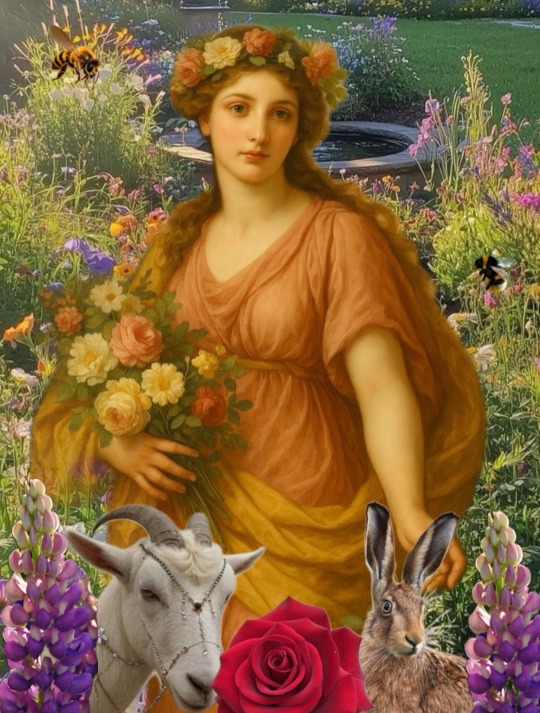
All About Roman Goddess Floris/Flora
Other names: Chloris (Greek), Florea, Flosa, Flos, Fluusa, Flora Rustica (Of Countryside), and Flora Mater (Flora the Mother)
Attributes
Spring
Vegetation
Fertility
Fertility (sexual)
Harvest
Nature
Games
Agriculture
Flowers
Flowering Plants especially if they produce fruit
Restoration of Plants/Flowers (Delaying and Averting rust and decay)
Symbols:
Chariot
Fruit trees
Bees
Lupines
Bean flowers
Goats
Vetch flowers
Hares
Grain
May poles (modern)
Offerings
Herbs (incense)
Flowers
Plants
Games (playing cards, board games) especially during her festival Floralia
Honey
Wine any kind of alchol
Gardening
Taking care of plants, trees, and flowers
Tarot:
The Empress
Queen of Pentacles
Nine of Pentacles
The World
“Come, Mother of Flowers, that we may honor her with merry games.” Ovid, Fasti
General information
The Goddess Flora is and one of the important goddess in Ancient Pagan Roman society and religion with good reason. Flora not only known to the Latins but before the republic she was known to the Sabines, Samnites, and Oscans (these were other tribes living on the Italian peninsula before unification of Rome). A Sabine King named Titus Tatius shared her with the Romans, they celebrated her during what would be the month of April and she was known among these tribes for growing crops and bearing fruit trees. She prevents any damage to crops and healing and preventing of any plant diseases like fungi. She was associated with a few goddesses like Pomona of Fruits and harvest but also Ceres. It’s also said she may have been merged with Chloris her Greek counterpart. Floris is her Latin name, it comes from “somethings in it’s prime” linking to prosperity, abunding, flourishing, fresh and blooming. It’s said that her name is one of the holy sacred names of Rome, also called “The hand maiden of Ceres”
She had a cult with a few priests called Flumen insituted by the famous King Numa who was the one that established Roman polytheistic religion, he was the second king of Rome known of his great piety. She had a temple in Rome near Circus Maximus a great statdium where chariot races took place and one on Qurinal Hill, her feast day would be April 28th the origins was because on April 28th, 281 was great drought ravished the land causing the vegetation to be barren. People decided to make the day April 28th to be dedicated festival for her in exchange for nature to return it was called Floralia and her second was on August 13th for ripening crops and blooming flowers.
During Floralia it would last about six or seven days with chariot races and circus games were held in her honor also a tradition for fertility scattering flowers like Lupines, bean flowers, and Vetches also letting loose goats and hares. The Romans would wear bright colors, wear flower wreaths especially roses. During the chariot races that were to go on for seven days usually one team would wear green being Flora’s team and the other is to be blue. Chariot racing and games has always been associated with her. Plays would be of actresses or prostitutes who were to entrain in the nude. People would decorate places with many flowers and get drunk on wine and dance. The last day of the festival would be called Florae where a ceremony to conclude the festival. Modern day people associate her with may poles and often include during her festival. One of her gifts to mankind was honey so bees can be often associated with her or other pollinators since they acquire flowers. But say you cannot have a chariot racing game for whatever reason any game is acceptable, who knows maybe she will allow Mario Kart but for real any game is perfect than none.
Her depiction
Flora was often depicted wearing a light spring clothing holding small bouquets of flowers, crowned with flowers.
Mythology
It’s said that she is the wife of the god Favonius God of the west wind association of fertility and spring as a gentle and favorable wind.
A famous story is of Queen Iuno/Juno who after finding out her husband Jupiter conceived a child and gave birth to Minvera without the help of a woman she became furious and went to Flora. Flora gave Iuno a magic flower that was able to make Iuno conceived and give birth to a child without the presence of a man, this child was the God Mars.
#paganism#witchcraft#hellenic polytheism#hellenic community#roman polytheism#italian traditions#italian folk magic#roman deities
24 notes
·
View notes
Text
Artnet: Saint Sebastian, The Gay Icon


Saint Sebastian by Guido Reni (left) and El Greco (right).
Despite Saint Sebastian’s popularity in art history, the details of his life are sparingly few. Saint Sebastian is venerated as an early Christian martyr and a saint by the Catholic and Orthodox churches and, according to fifth-century hagiography, during the Diocletian Persecution of Christians Sebastian, a member of the Praetorian Guard, was sentenced to death by the reining pagan Emperor Diocletian for espousing the teachings of Christianity.
He was tied to a tree and soldiers shot him with arrows, but according to Christian lore, Saint Sebastian miraculously survived, having been rescued and healed by Saint Irene of Rome. This scene of affliction and survival would become a popular artistic theme as early as medieval times, only growing more common in 16th- and 17th-century European painting.
Sebastian’s actual martyrdom, however, came after this initial assault. Having recovered, the saint attempted to confront the Diocletian face-to-face about his persecution of Christians. Guards clubbed the saint to death and his body was dumped into a sewer, only to be later recovered by Saint Lucy and buried in a Roman catacomb, where his remains are still today enshrined at the Basilica of St. Sebastian Outside the Walls.
Throughout the centuries, Saint Sebastian’s myth and legacy have shifted with cultural interests. During medieval times, Saint Sebastian was embraced as a patron of divine protection and culturally aligned with the god Apollo, resulting in the saint’s depiction as a beautiful and youthful young man (though often clad in armor, in keeping with his life as a soldier). With the emergence of the Black Death, however, his likeness shifted to one of a grizzled older man, more aligned with his historical age. His popularity as a protective intercessor against disease grew, however, and with it, his return to youthful attractiveness.
By the dawn of the Renaissance, artists were emulating prototypes of masculinity associated with the Greek world, and Saint Sebastian transformed into a figure of ephebic beauty—adolescent, lithe, idealized in form, and often covered only by a loin cloth. These images showed the saint, not in his actual moment of martyrdom, but in a more poetic moment of torture by arrows. Indeed, these Renaissance and Baroque depictions are rooted in the Catholic teachings about the permeability of saints’ bodies and the ecstasy experienced in their communion with the divine.
In the modern era, the popularization of Saint Sebastian as an icon in the gay community often leads back to Guido Reni’s Martyrdom of St. Sebastian (c. 1615) arguably the most famous depiction of the saint. Oscar Wilde was known to have adored the work, which is in the collection of the Palazzo Rosso, in Genoa. In fact, Wilde went so far as to adopt the pen name Sebastian while exiled in Paris during the last years of his life.


Yukio Mishima (left) and Sebastien Moura (right) as Saint Sebastian.
Reni’s painting was similarly influential to the famed 20th-century Japanese author Yukio Mishima; in Mishima’s 1949 novel Confessions of a Mask, the book’s adolescent protagonist experiences a homosexual awakening while gazing at the very same painting. The references to the saint didn’t end there—Mishima, who was himself gay, went so far as to pose as Saint Sebastian in a now-infamous photographic portrait, taken not long before the writer’s death by suicide in 1970.
In the visual arts, too, these allusions to the saint have cropped up repeatedly throughout the 20th and 21st centuries. In the 1970s, Italian artist Luigi Ontani staged a provocative photograph of Saint Sebastian as a gay icon. In the 1976 film Sebastiane, filmmaker Derek Jarman engaged with the narrative of the saint to explore ties between sexual and spiritual ecstasy, through a specifically homoerotic lens.
But what about these depictions of Saint Sebastian so resonated with the likes of Wilde and Mishima? Many observers, including Susan Sontag, have noted that Sebastian doesn’t yell out in anguish amid his wounding but endures the torment with an expression caught between pain and pleasure. Sontag called him the “exemplary sufferer.” His head is often flung back or forward rapturously. He conceals the depth of his emotions, experiencing both torments and pleasures privately, a feeling similar to the experience of gay identity for many men in the 20th century (and often to this day).
Others have interpreted the arrows piercing the saint’s body as phallic allusions and disguised references to homosexual sex, while his rope-tied hands can be seen through the lens of sadomasochism. Perhaps most concretely, the story of Saint Sebastian paralleled the experiences and fears of the closeted gay community—when Sebastian’s concealed true (Christian) identity was revealed, he was shunned, tormented, and killed by those in power, a harrowing tale that mirrored the gay experiences of being “outed” throughout modern history.
(Full article)
#saint sebastian#katie white#history#gay history#lgbt history#lgbtq history#art#museum#homoerotic#gay#lgbt#lgbtq#lgbtqia
35 notes
·
View notes
Text
An international study has revealed spruce trees not only respond to a solar eclipse but actively anticipate it by synchronizing their bioelectrical signals hours in advance into a cohesive, forest-wide phenomenon. The discovery, published in the journal Royal Society Open Science, shows older trees exhibit a more pronounced early response, suggesting these ancient sentinels retain decades of environmental memory and may use it to inform younger trees of impending events. This study adds to the emerging evidence that plants are active, communicative participants in their ecosystems, capable of complex, coordinated behaviors akin to those seen in animal groups. The lead authors are Professor Alessandro Chiolerio of the Italian Institute of Technology and University of the West of England, and Professor Monica Gagliano from Southern Cross University, Australia. "This study illustrates the anticipatory and synchronized responses we observed are key to understanding how forests communicate and adapt, revealing a new layer of complexity in plant behavior," said Professor Gagliano. "Basically, we are watching the famous 'wood wide web' in action."
continue reading
That they know when an eclipse is going to happen … I'm speechless.
#italy#plant research#plant communication#spruce forest#in sync reaction#eclipse#old growth trees#science#nature
21 notes
·
View notes
Text


















Palau de las Heures
Nueva
Hace un instante
Hi guys!!
I'm sharing Palau de las Heures. This is the 2nd building for my Catalunya (and Spanish) Collection!
I decorated some of the house ground floor, for reference.
House's history:
Very close to the Laberint d’Horta are the Palau de les Heures gardens, not as famous as the former but equalling it in beauty. Built along with the palace at the end of the 19th century by the architect August Font i Carreras, commissioned by the businessman Josep Gallart Forgas, the gardens feature tall palm trees along with other trees such as magnolias, acacias, cedars, orange trees, holm oaks, etc. Experiencing the full splendour of the gardens in springtime is a delight to the senses.
The French and Italian Renaissance-style garden, designed by Adrià Piera, is structured around three terraces, the highest being home to the palace and the first garden. The second and third – which is the largest – are the ones with the greatest landscape value, thanks to their leafy trees and numerous flower beds.
A hidden palace From the entrance to the park, the palace can be seen in the distance, lost among the palm trees, with two stairways that lead down to the garden. Built in the style of a French château, it has four cylindrical towers with conical peaks. Standing guard over the facade of the building are a group of sculptures which are an allegory of Les Heures by Josep Campeny.
Official residence of the Gallart family until the Civil War, for a while the palace was home to the president of the Generalitat, Lluís Companys. Later it became the property of Barcelona Provincial Council for public use, before becoming the Bosch i Gimpera University Foundation, linked to the University of Barcelona.
More info: https://www.meet.barcelona/en/visitez-la-et-aimez-la/points-dinteret-de-la-ville/jardins-92128095632
Floorplan:



------------------------------------
More pics:









House file:
Location: Barcelona, Spain
Style: chateauesque
Date: end of 19th century
This house fits a 50x40 lot.
I only decorated some of the important rooms. All the rest of the house is up to your taste to decor.
Hope you like it.
You will need the usual CC I use:
all Felixandre cc
all The Jim
SYB
Anachrosims
Regal Sims
King Falcon railing
The Golden Sanctuary
Cliffou
Dndr recolors
Harrie cc
Tuds
Lili's palace cc
Please enjoy, comment if you like the house and share pictures of your game!
Follow me on IG: https://www.instagram.com/sims4palaces/
@sims4palaces
DOWNLOAD, early access (06/15/2025):
#sims 4 architecture#sims 4 build#sims4#sims4building#sims 4 screenshots#sims 4 historical#the sims 4#sims 4 gameplay#thesims4#sims 4 legacy
16 notes
·
View notes
Text
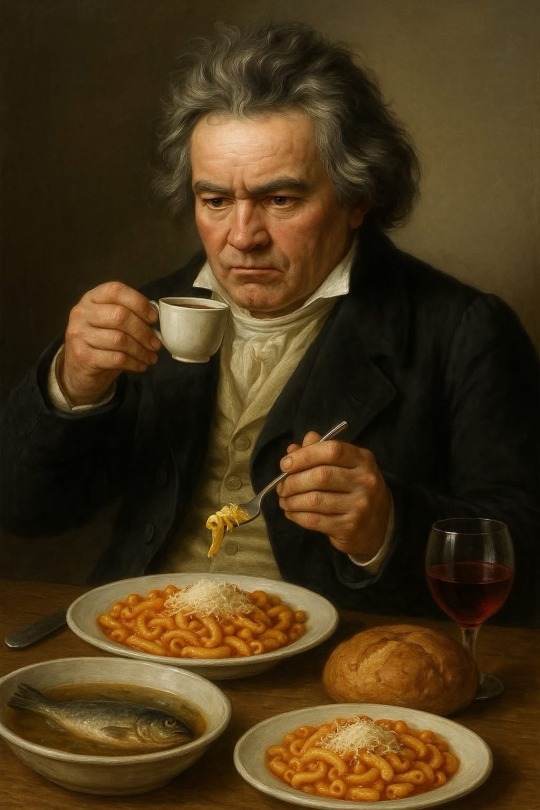
Beethoven’s Diet and Physical Exercise
(all dates are given in the Julian/Gregorian style current in the German-speaking lands; Beethoven lived 1770 – 1827)
1. How do we know what he ate and how he kept fit?
• Primary clues come from the Conversation Books (1818-1827) in which friends wrote to the deaf composer, from his letters, shopping lists and doctors’ case notes. The latest complete English edition (Boydell, 2018-24) lays out hundreds of food and errand entries as well as remarks about walking sticks, baths and spa cures
• Early biographers Anton Schindler (who knew him personally but sometimes embroidered the truth), Alexander W. Thayer and modern scholars such as Jan Swafford sift these fragments. Where Schindler is our only witness (for instance, the famous coffee ritual) I flag this in the text.
2. What did Beethoven eat?
Life-phaseTypical foods & drinksDocumentary trail
Childhood & Bonn years (1770-1792)
Rhenish staples: rye bread, river fish, root vegetables, local wine or beer. Evidence is thin, but memoirs of boyhood friends and the modest family income point to an un-luxurious, high-carb diet.
Early Vienna (1792-c.1816)
• Coffee: every morning he counted exactly 60 beans before grinding them
• Macaroni with Parmesan: an expensive Italian import he ordered by name; it turns up on grocery lists and in Schindler’s reminiscences
• Bread soup with 10 eggs every Thursday; housekeeper had to break and sniff each egg before it went in
• Fish over meat – pollock, pike and carp are mentioned most often
Late years & illness (1817-1827)
• Constant stomach pain and, after 1821, liver failure forced plainer fare: barley soup and soft-boiled eggs were prescribed by Dr Braunhofer during a severe intestinal attack in 1825
• Dr Andreas Wawruch’s final medical report, quoted in a modern medical review, confirms recurrent jaundice and a “moderate fish-and-rice diet” during the last months
• Alcohol: friends recorded light Austrian wine and beer at table, but physicians eventually banned it; post-mortem analyses still blame both alcohol and likely lead-adulterated cheap wine for cirrhosis.
Rituals & quirks
• Hyper-scrupulous freshness tests (holding eggs to the light, smelling meat); endless notes such as “Sugar. Spice. Wine. Macaroni. Tooth-powder.” appear in the Conversation Books
• Deep distrust of servants: “Anyone who tells a lie has not a pure heart, and cannot make good soup,” he reportedly snapped
• A sweet tooth only for coffee: he called it “more delicious than a thousand kisses”
3. How did he exercise?
1. Daily, often marathon, walks
◦ Beethoven himself wrote (1803): “How glad I am to roam in wood and thicket, among trees and flowers and rocks”
◦ Contemporaries noticed the routine: after a light noon meal he set off “for walks that lasted the entire afternoon and often deep into the night,” returning only for a late supper and bed
◦ The Vienna Woods, the Prater meadows, and summer villages such as Heiligenstadt, Döbling, Mödling and Baden were favourite circuits; today’s “Beethoven Wanderweg” follows part of his track
◦ He always carried a pocket sketch-book to jot motives; manuscripts for the Missa solemnis and the late sonatas originated on these hikes
2. Water therapy and bathing
◦ From the 1790s his doctors ordered cold (later tepid) “Danube baths” for bowel troubles and for the failing ears. Beethoven believed they “worked wonders” for his stomach, even if they did nothing for hearing
◦ Conversation Books even note his curiosity about an inflatable “swimming belt” advertised in 1820
◦ Modern medical historians confirm he spent up to six months a year at spa resorts, making balneology a life-long treatment
3. Cold-water ablutions at home – morning bucket douches, praised by friends as part of his “superhuman robustness”
4. Later limitations (1825-27)
Ascites, oedema and severe pain curtailed the distances he could walk, yet even in the final Conversation Books we read errands such as “Have a walking-stick made; dust-broom; hemp cord” . His last prolonged spa cure at Baden was cut short when his abdomen had to be tapped four times for fluid.
4. Putting it together
Beethoven’s diet was paradoxical: frugal, repetitive and dominated by coffee, simple soups, fish and pasta — yet executed with fanatical precision. Combined with hours of outdoor walking, cold water therapy and seasonal spa retreats, it gave him the stamina for 12- to 15-hour workdays well into his fifties. Unfortunately, genetic susceptibility, contaminated wine and 19th-century medicine finally overtook whatever health benefits those habits conferred.
Still, the habit of “thinking on foot” left its mark on works from the Pastoral Symphony to the late quartets. In the woods, he told a friend, “Every tree seems to say: Holy! Holy!” — an echo that survives in his music long after the bread soup and 60-bean coffee have vanished from history.
🎶Thank you Alex Rosas Navarro • FB @ Beethoven Group
#beethoven#beethovenlife#beethoven portrait#ludwig van beethoven#a classical life#classical music#art#18th century#classical history#classical art#classic#classical composer#classical#classical musician
13 notes
·
View notes
Note
if Marc and Vale were mountains, what characteristics would they have? low and flat? very tall and isolated? in the tropics? in the arctic? with trees at the base? actually a dormant volcano?
this is a question for my BROTHER but i refuse to go to him with rpf. my first thought well they arent appalachian mountains either of them. but i COULD make a joke about vale and the OLDEST MOUNTAINS IN THE WORLDDDDDDD etc etc. hm. marc i think is actually a cliff. danger imminent. beautiful in a way that still makes your intestines clench up inside bc there some inherent hazard to life there that your lizard brain recognizes and is somewhat scared of. maybe the ocean knocks on his door every day and he patronizes young daredevils who like to cliff dive. hes striking, he demands your full attention, and he makes you think about dying like all the time. thats marc as mountain. alternatively. K-2 lmao. demanding and WILLLLLLL kill your ass. 20% death rate on that bad boy
vale. what kind of mountain is a SHOW well ladies you guessed it hes a volcano. im thinkin in the vein of mount etna. which i know is in sicily and this guy aint sicilian, but it IS an italian volcano famous in geologist circles and its where those vulcanologists who fell in love (and died) met and i think thats nice. a lil romance a lil show a lil mythology (said to be where vulcan keeps his forge. fun). mt etna ALSO contributes its ash to the soil surrounding it and supports a really robust agricultural network and i think that is SOMEWHAT what his ass does for young riders and the tavullian economy writ large. che spettacolo.
32 notes
·
View notes
Text
MHA Dr #1

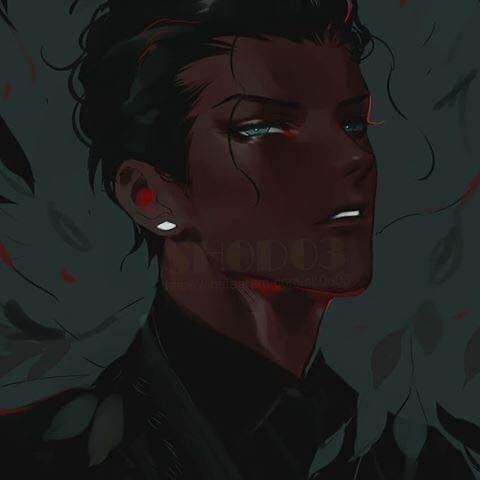

Name: Sora "Aaron" Senju Uchiha
Birthday: January 24
Height: 6'5"
Appearance: So his faceclaim is ^ but I also wanted him to look more like an Uchiha so he would have dark raven hair, like the Uchiha's in Naruto and the same eye color. Might make his hair a bit more curly
Voice claim: a deep male voice with a British accent. Think Hobie Brown and Howl Pendragon combined
Backstory: So long story short, in this reality I'm born in Japan but because I'm from two famous clans (half Senju, half Uchiha), my family moved to London and that's where I trained and I was homeschooled up until highschool. I move back to Japan a week before the entrance exam. Even though I could get in through recommendations, it would be more fun to go through the exams and take first place and put Bakugo in his place. I have two siblings who are twins (Minari and Masuru) and will grow up around Eri's age.
Quirk: Senju Sharingan (I'm horrible at names lol 💀) It's a unique quirk that combines the Uchiha clan's Sharingan and the regenerative abilities of the Senju clan. I'm also able to use Wood Release as well (For non-naruto fans, it's like a nature quirk with trees but more destructive).
Extra info -
So for my quirk, I can do ninjustu, learn taijutsu, and learn genjustu too. Instead of having to see people die to activate my sharingan, i just scripted I will have to train really hard and break my limits to get my sharingan and upgrade it too. Same goes for getting my mangekyo sharingan cause why would I give myself more trauma?
I scripted so many things for me being handsome it's not even funny 💀. I came there to steal attention and be hot and wanted, not to be a side character 🥱
I'm half Nigerian, half Japanese (fully Nigerian here). I know Japanese, Yuroba, Igbo, Chinese (or Mandarin), French, Spanish, English, Korean, and Italian
Skills: dance, bake, cook, sing, garden, play lots of instruments, do martial arts, ice skating, skating, thinking outside the box, roller skating, judo, teamwork, decision making, learning, listening, fighting, observing, problem solving, math, styling clothes, styling hair, taekwondo, karate, kung fu, exercising, mindfulness, meditation, flexibility, high stamina, learning choreography fast, good memory, hyper focus, Capoeira, muay thai, kickboxing
I play the violin, electric guitar, bass guitar, piano, trumpet, flute, upright bass, cello, and clarinet 🥱🥱
My mom is Tsunade and she's half Nigerian half Japanese. So is my dad. My siblings were born in London. We're rich and loaded, like Momo Yaoyurozu loaded. Might make myself even more richer than her.

My script in my Google docs is like 39 pages, and it's mostly full of extra stuff I scripted 🫣 but yeah if you want more questions, do ask away ✨I love yapping about my drs. The next three are coming your way 💁🏾♀️
@cocozydiaries 😉🫡
-Honey out 🍯🍯
#reality shift#shifting community#shifting reality#anti shifters dni#black shifters#bnha shifting#mha shifting#my hero academia reality shifting#reality shifter#reality shifting#shiftblr#shifter#shifters#shifting#shiftinconsciousness#shifting antis dni#shifting blog#shifting motivation#shifting realities#shifting scenarios#shifting script#shifting to mha#shifting tumblr#shiftingrealities#shifttok#shifting consciousness#manifesting#Honey dr 🍯
131 notes
·
View notes
Text
don't ask the gods to help you because they're afraid of me || Death Note fic
So I've been getting really into writing my Death Note fic recently, so I decided I'd post some moodboards! Right now I've just done them of the main love triangle: Light, L and Mikami. But I'm hoping later in the fic other characters will be just as prominent, such as Sayu, Misa (I haven't decided how she'll come in but I love her too much to forget her), Light’s parents, the Wammy kids. I'm even hoping to include B at one point! Here are the moodboards, and I'll explain a bit about the fic below them:
Light Yagami

Light Yagami cares about nothing but his work (except perhaps his sister). Despite this, he's recently engaged to his boyfriend of three years, Teru Mikami, not because he loves him, but because it fit his five year plan.
Not long after his engagement began, Light meets a man who goes by Ryuuzaki, but turns out to be world-famous detective, L. L hires Light on the spot, straight out of university, for reasons unknown to Light, who is willing to grasp any opportunity who comes his way, no matter how strange; and he knows he's not going to get a much better offer than L.
(Other moodboards under "read more")
Teru Mikami

Teru Mikami is a lawyer who seemingly lives to be with Light. Deeply in love, he's willing to overlook the fact that it's unrequited, although deep down he is aware of it. He's upset when Light announces that he's taking a job which will require constant travelling, but knows that Light is far too difficult to argue with. He has to sit by and plan his wedding while his fiancé drifts even further away than he already was—but becomes more involved when he realises who Light’s new boss is.
L Lawliet

L Lawliet is tortured by memories of a past life. Although he chose his own fate, he has spent 30 painful years waiting for the day when it would be reasonable to seek out his lost love, Light Yagami.
When he finally finds and approaches him, L discovers that Light is recently engaged to somebody else; but this doesn't stop L from trying to get Light back. Offering Light a job, L ensures that they work out of the country, keeping Light away from his fiancé.
This story is in Light’s first person P.O.V.! I'm going to put an excerpt of the beginning just below and a link to the AO3 page ♡
As Teru leads me to an outside table at this very luxurious Italian restaurant in Tokyo, I immediately get a terrible feeling. Don’t get me wrong; I like the finer things in life, within reason, and Teru knows this, although he’s naturally a more modest type of person. It isn’t the restaurant which bothers me, because I deserve to be somewhere this beautiful and expensive. It’s why Teru would spontaneously decide to take me somewhere this nice with no particular occasion that bothers me. Usually he would say this kind of thing is excessive, gluttonous, greedy, that it’s a road to us becoming a couple of Elon Musks and fucking up Twitter. As he helps me into my seat because his manners are second to none, I offer him a charming smile and admire the scenery. There are white curtains falling between each table; we’re in a patio of sorts with a roof above our heads, and little stairs leading up to us covered in lanterns. There are trees all around, and potted plants. It is atmospheric. I belong in places like these; they compliment my elegance. I’m avoiding looking at Teru as he sits down. “Do you like it?” he asks me. He’s wearing a very nice suit. He always looks handsome but tonight an extra effort has been put in, I can tell. I think I might be feeling sick. I’m hoping to send appropriate signals that stop the terrible event from happening. “It’s beautiful,” I answer, gently fingering the side of my menu. I just had a manicure, and my hands look perfect in this light; just like the rest of me I imagine. Oh my God, I think I look too good. I should have tried less hard but I didn’t realise what was happening until I’d already dressed and then caught sight of him looking like a very muscular Tom Ford catwalk model. I’m sending signals I don’t want to send by way of my resplendent beauty. “Just like you,” he says, smiling. I knew it. He’s such a sap, he’s always been that way, I’ve always put up with it. We make sense together but I don’t want to go too far with it. “I know how I look, Teru,” I say with a deep breath, and begin to read the menu. I am going to need alcohol. Wine feels appropriate but would also only worsen this situation. As I read the menu I really wine is definitely where this is headed. “We’ll get the seven courses with wine,” Teru says like he’s in charge in this relationship. Yes. We will get that because it’s one of the few options on offer. I hate how delicious it all sounds. Oh, crayfish. I don’t get to have that often. I can’t believe I’m letting this happen. I should fake a sudden illness and run. “We’ll ask the sommelier what wine he suggests and go for it.”
“OK,” I say. He’s not even popped the question yet but this has turned into one of those situations where you marry a man and then he thinks he can tell you what to do. I think I have better taste in wine than the sommelier. I know my own tastes. Why are we asking the sommelier? What’s wrong with me tonight?
AO3 link:
None of the images in the moodboards are mine, and neither are the lyrics written on them!
#death note#light yagami#teru mikami#l lawliet#light x l#light yagami x l#light x mikami#mikalight#lawlight#don't ask the gods to help you because they're afraid of me
27 notes
·
View notes
Text
Hot Like Ice

Summary: For Christmas, John and Santino decided to vacation in Venice. The cold won't stop them from getting their hands on each other, quite the contrary.
Rating: Explicit
Relationship: Santino D'Antonio/John Wick
Note: A festive fic with these two going to Advent and well... yeah ;)! It was supposed to be shorter and with no smut, but oh well, it's these two. They take over the fics all the time. I was also going through a lot during all this, but I managed to finish it, and it's here! :]
☆ SPECIAL THANKS TO @mrssimply ☆ for beta reading and helping out! I appreciate it a lot! <33
Please enjoy the festive steamy with these two! ^ ^
✦ . ⁺ . ✦ . ⁺ . ✦
Snippet
December arrived quickly and so did the festive spirit. Even if Santino struggled to admit it, he liked it. He liked all of these decorations, the lights, even some sweets. There was a special spark in his eyes whenever they would walk together and Santino would look at all those colorful decorations with a shy smile.
Then again, there was one big problem for Santino with winter. The cold. He liked snow, the aesthetic of it, but really he was always complaining to John about the cold. Or when he was shivering even at home, John literally bought a couple of blankets just for him.
Especially when Santino would fall asleep by his working desk or on the couch after overworking himself to the point of passing out from exhaustion. If he was really deep asleep, John would carry him to the bed and then put the blanket over him, but if his partner was half awake and muttered something tiredly to leave him alone, he would put the blanket over him and kiss his head. In those cases, Santino either stayed like that or followed John in bed with the blanket over his shoulders and snuggled against his warm lover.
Either way, the Camorra prince didn't like feeling cold.
They were spending a few weeks off their work— actually Santino's work, in Venice for Christmas holidays. John suggested Rome at first but there were too many hurtful memories that his companion wished to forget from there.
“I always wanted to visit Venice,” Santino finally confessed shyly after rejecting holiday offers all day. With that, it was decided. Venice was the place.
It really was beautiful, especially now with so many decorations and lights. While the whole city was gorgeous, what was most appealing to John was his lover who finally looked like he was truly happy. That smile on Santino's face, the look in his eyes as he explored every detail he could spot, that was the most important thing to John.
He also appreciated how Santino got dressed so handsomely. A black jacket John had gifted him as an early present, of course from a famous Italian brand, a waistcoat hidden under the coat with a tie, and a gray soft scarf to try and keep him warmer. A stunning look, Santino was definitely the most handsome guy there.
“You look beautiful,” John said breathlessly when they stopped by a tree decorated with lights, stunned by his partner's looks, and how handsome he was.
Santino chuckled, caught off guard, “You said that already so many times in the apartment and on our way here.” They were just about to enter the Advent.
“Well, it's never enough,” the other man murmured and leaned to kiss him on the cheek. His usually warm face was now a bit colder. No wonder, it was almost freezing outside. “Are you cold? I can give you my jacket-”
“It's fine, don't worry. I just have to get used to it, that's all,” Santino replied with a soft smile. “I can smell the mulled wine from over here, I've been craving it for a while. I wonder how good they are making it here. I bet it's better than the ones in New York.” He winked playfully and pulled on John's arm to make him follow.
Read the rest on Ao3
#the Advent fic! ^ ^#this wasn't even supposed to be smut but like i said Santino and John took over#BUT YEAH HERE WE ARE YAY#the freaks at advent >:]#wickedsaint#santino d’antonio#santino d'antonio#john wick#john wick x santino d'antonio#my writing#wickblr
15 notes
·
View notes
Note
kitty !!

just cut the FOCKIN tree down!! 🤌🤌
omg kitty :00
rip natalies italian accent youll always been famous
13 notes
·
View notes
Text
𝐅𝐀𝐍𝐓𝐀𝐒𝐘 𝐍𝐀𝐌𝐄𝐒 : here are a list of 55 female names, 55 male names and 55 a song of ice and fire valyrian names and last names. You can do variations to the names and eveything because, you know fantasy, but I chose those that I thought sounded good. If this list is good, I found a generator for more fantasy names centered in ASOIAF for different kingdoms and lands. you don't have to give credit but please like or reblog if you find useful.

Male Names.
Kallias, meaning beauty.
Dimitri, earth lover.
Teivel, the devil.
Kaiser, Emperor or ruler.
Harvey, Strong warrior.
Lysander, liberator.
Erel, angel and messenger.
Asael, made by god.
Laurent, the bright one.
Perseus, avenger, destroyer.
Chrysander, golden protector.
Zale, strength of the sea.
Cahir, warrior, battle man.
Magnus, great and powerful.
Nikolai, people of victory.
Kian, king.
Damien, to tame.
Micah, who resembles God.
Kaemon, joyful.
Arsenio, strong, potent.
Lucius, light or genius.
Loan, light.
Calix, very handsome.
Rowan, brilliant red.
Egan, little fire.
Adonis, lord.
Declan, full of goodness.
Arzhel, bear prince.
Thaddeus, courageous heart.
Alastor, vengeance.
Carden, wool carder.
Leone, lion.
Osian, little dear.
Ezekiel, strength of god.
Zion, highest point.
Asher, blessed.
Kratos, strength, might.
Zadkiel, righteousness of god.
Arwan, king of the other world.
Malakai, messenger.
Acheron, river of sorrow.
Elijah, the lord is my god.
Jace, lord of salvation.
Killian, little warrior.
Cyrus, the sun.
Deimos, personification of fear.
Bryson, child of a noble.
Conan, little wolf or little hound.
Maverick, independent one.
Lennone, keen.
Anteros, god of required love and defender of unrequired.
Denarius, silver coin.
Lorcan, little fierce one.
Ariston, excellent.
Vortigern, high overlord.
Female Names.
Naima, tranquil.
Freya, noble woman.
Alora, beautiful dream.
Danyi, sweet.
Juniper, evergreen.
Arcadia, adventurous.
Cora, virtuous.
Rosela, rose in italian.
Rhea, river.
Kyra, sun.
Solasta, shining, light.
Evangeline, messenger of good news.
Narcissa, flower.
Nyssa, new beginning.
Nyx, night.
Elodie, great fortune.
Gemena, intelligent.
Elis, god’s promise.
Irene, peace.
Samira, wind.
Melantha, dark flower.
Odeliah, praise god.
Aleyah, noble, elevated.
Sariah, princess of the lord.
Ilaria, happy and cheerful.
Odessa, long journey.
Jezebel, pure.
Brielle, heroine of god.
Emersyn, brave, powerful.
Marilla, shining sea.
Braelyn, meadow.
Enora, honor.
Sereia, mermaid.
Seraphina, fiery ones.
Kaena, praise.
Zenaida, of zeus, eternal life.
Isadora, gift of Isis.
Faera, bringer of gifts.
Fayra, gift of god.
Lilibet, pledge to god.
Orlaith, golden princess, sovereign.
Thalassa, sea or ocean.
Visha, deadly poison.
Sora, sky.
Leysa, defender of man.
Cassiel, angel of saturday.
Calia, beautiful person.
Aloisia, famous warrior.
Isleen, vision.
Elowen, elm tree.
Davina, beloved.
Elysia, from the blessed isles.
Gwenna, blessed ring.
Mairween, blessed rebellion.
Esmeray, dark moon.
ASOIAF Valyrian names.
Daenar Tarreos
Baesenyx Barreos
Jaererys Laeraellis
Tyraerion Laenaenor
Jacaegar Laeneneos
Gaedar Aglaeris
Raenor Gonnalys
Rhaegon Maentigar
Vimar Arnalys
Vahaegaron Nargyreon
Laegor Naeltigar
Aeron Taeltheon
Maerya Barnaris
Alyhna Caeneneos
Vysenera Naeltaris
Daessa Baelnaris
Baessa Rahmaereon
Haelera Veltheos
Saerena Arinarys
Alaenna Lenyreos
Elaessa Narnareon
Jaelanya Galgyreon
Vhaenys Dortalor
Saerera Raeldaerys
Visegon Goniar
Jaedor Gaelennis
Malaelor Maentheos
Rahaelon Baeltigar
Maerion Laergaris
Visegon Qargaeron
Vahaeron Arreos
Gaelyx Arlaeris
Garaevon Calnalys
Naelara Dalreos
Eraerla Raenlaeris
Daenenera Maenanyon
Haerys Narnalys
Hera Aergaris
Vysessa Qarareon
Elaerya Aerlaeris
Maeharys Malreos
Tahaenyx Rahiar
Aeganar Gaelralis
Balaevar Lendaerys
Daegar Valanyon
Gaegar Nohaellis
Matagor Vellaeris
Rahaemon Laendaerys
Daelon Aeraeris
Aerena Mallaeron
Daenelys Callaeris
Renaera Raelennis
Daenelys Dortheos
Raevor Daerlaeron
Bamera Caenennis
79 notes
·
View notes
Text

Calabria, the toe of southern Italy is one of the country’s least-known regions and probably the most underrated one.
Calabria is best known for its beautiful sandy beaches along the Tyrrhenian and the Ionian Sea, and its dramatic cliffs, coves, and rock formations: 800 km of coastline, stunning turquoise waters and green hills adorned with olive, orange, and lemon trees.

The heart of the region offers a pure and unspoiled scenery, comprised of thick forests, dotted with canyons, streams, and waterfalls and three national parks: Aspromonte, Pollino (UNESCO heritage site), and Sila.
The warm weather, the wild and mysterious nature, the strong and genuine flavors of local food and the vestiges of its ancient origins, when it was a colony of Greece, make Calabria an ideal destination all year around, without the long-haul flights of more exotic destinations.
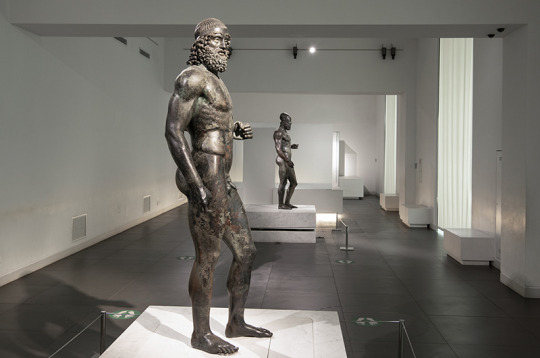
Art lovers cannot miss the famous Riace bronzes, that were found in the Ionian Sea near Riace in 1972 and exhibited in the National Museum of Reggio Calabria. These beautiful statues, probably two warrior heroes larger than life-size, are a fine example of classical Greek sculpture.
Reggio's ancient history predates the Greeks, who settled this strategic location at the exact center of the Mediterranean in the 8th century BC. They called their colony Rhegion, which was subsequently Latinized by the Romans and transformed through the ages under the area’s various rulers.

In Reggio Calabria, the lungomare or waterfront is a great place for a stroll, either down at beach level or along the upper promenade, which flanks what is commonly referred to as Via Marina, a pair of north-south coastal roads laid out in boulevard style. The approximate two-kilometer strip of land between serves as a lovely city park the length of the downtown area.
Stately mansions face this public garden and the strait beyond.
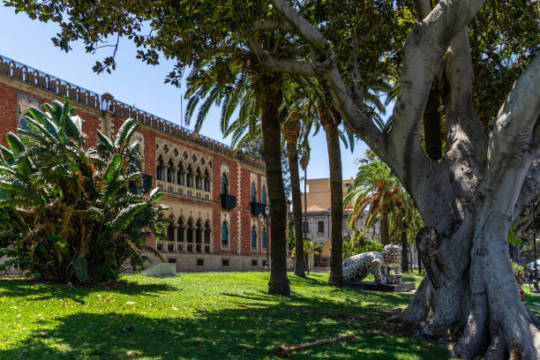
The seafront elegant, panoramic promenade lined with palm trees, with its views across the Messina Strait, which divides the Italian peninsula from the island of Sicily, to Mt Etna is one of the most atmospheric places for a walk.
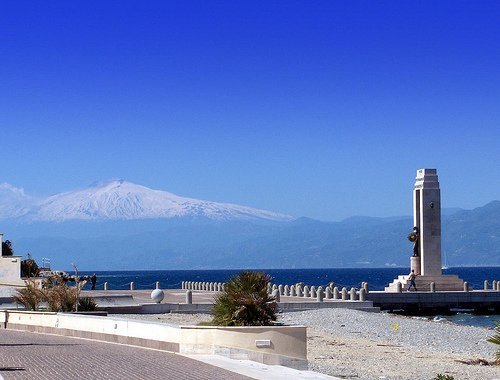
Capo Vaticano is considered one of the 100 most beautiful beaches in the world: a long beach of fine sand with crystal clear waters, surrounded by ancient trees.
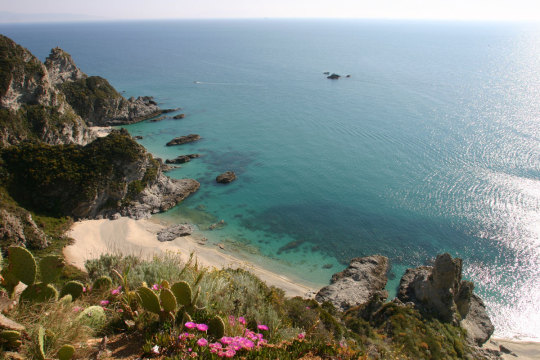
Tropea, a puzzle of lanes and piazzas, is one of Calabria’s most attractive towns. It is set in a dramatic spot on a cliff where the houses seem to blend into the rock. Tropea is famed for the spectacular sunsets, between the cliff and the rocky promontory with the church of Santa Maria dell’Isola.
Stacked high up on a sea cliff, there is Pizzo with its unique Church of Piedigrotta, entirely carved out of tuff stone.
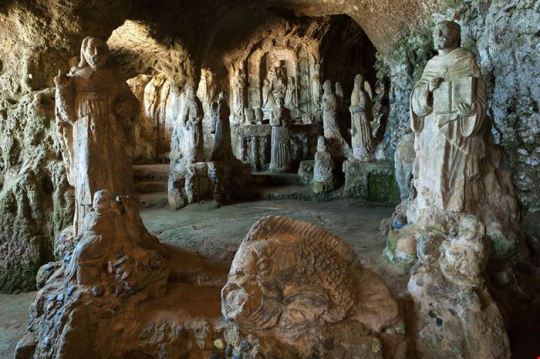
Chili pepper, ‘nduja and Tropea onions are the first ingredients that come to mind when talking about Calabrese cuisine.
Calabrians love chilli peppers and they add it in everything, from pasta to ice-cream! Every September, the “peperoncino” festival takes place in Diamante to celebrate its locally produced food.
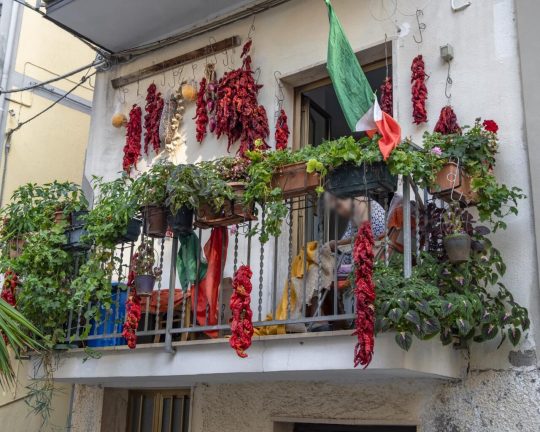
‘Nduja is the Calabrian version of salami. A spicy, spreadable cold cut with chilli peppers (of course) and spices.
Tropea’s red onion is known for its mild, sweet flavour. In fact, these onions are so famous that cipolla di Tropea has become a Calabrian symbol.
Follow us on Instagram, @calabria_mediterranea
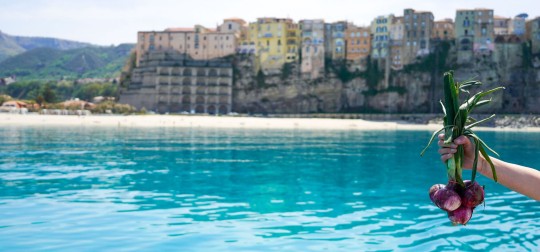
#calabria#italy#italia#south italy#southern italy#mediterranean#italian#tropea#reggio calabria#red onion#chili peppers#chili pepper#chili#ancient art#ancient#history#ancient history#bronzi di riace#riace bronzes#magna graecia#greek#greek art#sculptures#bronze#landscape#europe#italian landscape#italian landscapes#landscapes
137 notes
·
View notes